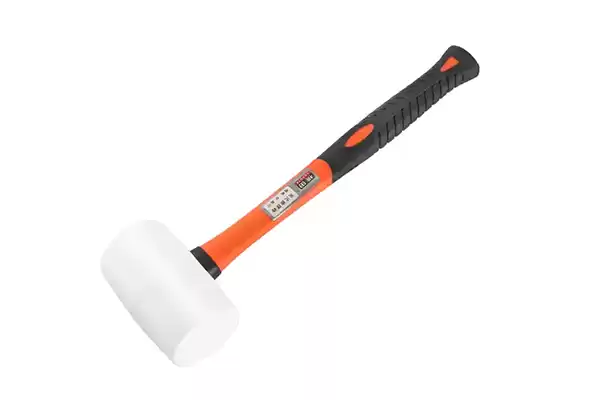A rubber hammer, also known as a mallet, is a versatile tool widely used across various industries for tasks that require force without causing damage to surfaces. The hammer’s head is made of rubber, which distributes the force more evenly compared to traditional metal hammers, making it an essential tool for delicate tasks where a standard hammer might cause unwanted damage. This article explores the different uses of rubber hammers and why they are important in professional and DIY applications.
1. Furniture Assembly and Carpentry
Rubber hammers are commonly used in furniture assembly and carpentry projects, particularly when dealing with materials that are prone to damage or scratching. Whether working with wooden pieces, assembling furniture, or handling delicate joints, the rubber hammer ensures that parts can be tapped into place without harming the surface. Some specific applications include:
- Fitting Wood Joints: Rubber hammers are perfect for gently tapping wood joints together, especially in tight-fitting carpentry projects. When force is required to join pieces, a metal hammer might dent or mar the surface. The soft rubber head, on the other hand, provides sufficient force while maintaining the integrity of the wood.
- Furniture Assembly: When assembling prefabricated furniture, especially those made of particleboard or engineered wood, using a rubber hammer prevents splitting or damaging the edges. It helps knock pieces into place without applying excessive pressure.
This makes the rubber hammer a go-to tool for woodworkers, furniture assemblers, and DIY enthusiasts who want precision without the risk of surface damage.
2. Automotive Repairs
In the automotive industry, rubber hammers are used for a variety of tasks where precision is key. Mechanics often need to apply controlled force without the risk of damaging sensitive parts, which makes rubber hammers an excellent choice for:
- Bodywork: In auto body repair, rubber hammers are used to reshape or align panels, doors, and fenders without damaging the metal. Unlike metal hammers, which can cause dents or scratches, rubber hammers can help gently tap body panels back into position.
- Installing and Removing Parts: Rubber hammers are ideal for tapping parts such as hubcaps, bearings, or seals into place without damaging them. They provide the necessary force without risking injury to the components.
- Wheel Maintenance: A rubber hammer can be used to loosen or tighten wheel bolts or nuts without causing damage to the wheels or tires. The non-marring properties of the rubber make it safer to use than traditional metal tools.
The ability to exert force while reducing the risk of damage is why rubber hammers are an essential tool in auto repair shops.
3. Tile and Flooring Installation
Rubber hammers are commonly used in the installation of tiles, laminate, and other types of flooring. The precise force they provide makes them perfect for laying materials evenly without cracking or breaking fragile tiles or boards. Specific uses in this industry include:
- Tile Laying: When installing ceramic or stone tiles, a rubber hammer can be used to gently tap them into place, ensuring they are level and securely adhered to the floor or wall. This prevents tiles from shifting or cracking during installation.
- Laminate Flooring: When installing laminate flooring, a rubber hammer helps snap boards into place without damaging their edges. It can be used with a tapping block to prevent dents and scratches while ensuring a tight, even fit between panels.
Using a rubber hammer during flooring projects ensures that the materials are installed smoothly, minimizing the risk of cracks or misalignments.
4. Masonry Work
In masonry, rubber hammers are used for delicate stonework and bricklaying tasks. While bricks and stones are hard materials, improper handling with metal hammers can lead to chips, cracks, or other forms of damage. Rubber hammers provide a softer approach while still delivering enough force for precision tasks. Examples include:
- Bricklaying: Rubber hammers are used to adjust and level bricks during construction. They can tap bricks into alignment without risking breakage, ensuring an even wall or structure.
- Stone Work: For working with natural or decorative stones, a rubber hammer helps move or adjust pieces without damaging their surfaces. This is especially important when dealing with expensive or delicate stone materials.
Rubber hammers allow masons to work more delicately, preventing accidental damage to stones or bricks that could otherwise result in costly repairs.
5. Camping and Outdoor Activities
For outdoor enthusiasts, rubber hammers are an essential tool when setting up camp. Their soft yet effective design makes them useful in a variety of settings:
- Tent Setup: Rubber hammers are commonly used to drive tent stakes into the ground without damaging the stakes or bending them. The malleable rubber head applies just enough force to secure stakes while preventing excessive force that could break or warp them.
- Outdoor Construction: Whether building a temporary structure or making small adjustments to outdoor gear, a rubber hammer can help tap components into place without causing damage.
The lightweight nature and gentle force of a rubber hammer make it an ideal companion for outdoor and camping applications.
6. Plumbing and Pipework
In plumbing, rubber hammers are often used to adjust pipes or fixtures without damaging them. Metal hammers may dent or crack pipes, leading to leaks or costly repairs, but rubber hammers provide controlled force to:
- Adjust Pipes: Plumbers often use rubber hammers to nudge pipes into position without causing any damage to the material, especially for more delicate materials like PVC or copper.
- Fix Fixtures: Rubber hammers can be used to install or adjust fixtures, taps, and other components without scratching or breaking them.
The rubber head ensures that pipes and fixtures remain intact while being properly aligned or installed.
Conclusion
A rubber hammer is a highly versatile tool that finds use across many industries, from carpentry and automotive repairs to tile installation and outdoor activities. Its ability to provide controlled force without damaging surfaces makes it ideal for delicate tasks where precision and protection are crucial. Whether you’re a professional tradesperson or a DIY enthusiast, a rubber hammer is an indispensable tool for ensuring that projects are completed with accuracy and care.
Post time: Sep-24-2024







